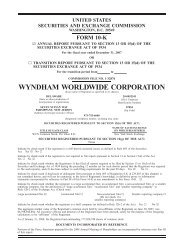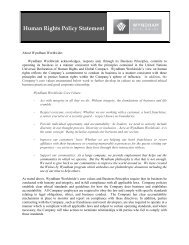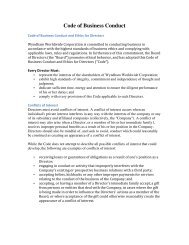WYNDHAM WORLDWIDE CORPORATION
WYNDHAM WORLDWIDE CORPORATION
WYNDHAM WORLDWIDE CORPORATION
Create successful ePaper yourself
Turn your PDF publications into a flip-book with our unique Google optimized e-Paper software.
eal estate inventory costs incurred to total estimated costs. These estimated costs are based upon historical<br />
experience and the related contractual terms. The remaining revenues and related costs of sales, including<br />
commissions and direct expenses, are deferred and recognized as the remaining costs are incurred.<br />
We also offer consumer financing as an option to customers purchasing VOIs, which are typically collateralized<br />
by the underlying VOI. The contractual terms of Company-provided financing agreements require that the<br />
contractual level of annual principal payments be sufficient to amortize the loan over a customary period for the<br />
VOI being financed, which is generally ten years, and payments under the financing contracts begin within 45 days<br />
of the sale and receipt of the minimum down payment of 10%. An estimate of uncollectible amounts is recorded at<br />
the time of the sale with a charge to the provision for loan losses, which is classified as a reduction of vacation<br />
ownership interest sales on the Consolidated Statements of Operations. The interest income earned from the<br />
financing arrangements is earned on the principal balance outstanding over the life of the arrangement and is<br />
recorded within consumer financing on the Consolidated Statements of Operations.<br />
We also provide day-to-day-management services, including oversight of housekeeping services, maintenance<br />
and certain accounting and administrative services for property owners’ associations and clubs. In some cases, our<br />
employees serve as officers and/or directors of these associations and clubs in accordance with their by-laws and<br />
associated regulations. We receive fees for such property management services which are generally based upon total<br />
costs to operate such resorts. Fees for property management services typically approximate 10% of budgeted<br />
operating expenses. Property management fee revenues are recognized when earned in accordance with the terms of<br />
the contract and is recorded as a component of service fees and membership on the Consolidated Statements of<br />
Operations. We also incur certain reimbursable costs, which principally relate to the payroll costs for management of<br />
the associations, club and resort properties where we are the employer. These costs are reflected as a component of<br />
operating expenses on the Consolidated Statements of Operations. Property management revenues were $405 million,<br />
$376 million, and $346 million during 2010, 2009 and 2008, respectively. Property management revenue is<br />
comprised of management fee revenue and reimbursable revenue. Management fee revenues were $183 million,<br />
$170 million and $159 million during 2010, 2009, and 2008, respectively. Reimbursable revenues were $222 million,<br />
$206 million, and $187 million respectively during 2010, 2009, and 2008. Reimbursable revenues are based upon<br />
cost with no added margin and thus, have little or no impact on our operating income. During 2010, 2009 and 2008,<br />
one of the associations that we manage paid Wyndham Exchange & Rentals $19 million, $19 million and<br />
$17 million, respectively, for exchange services.<br />
During 2010, 2009 and 2008, gross sales of VOIs were increased by $0 and $187 million and reduced by<br />
$75 million, respectively, representing the net change in revenues that was deferred under the POC method of<br />
accounting. Under the POC method of accounting, a portion of the total revenues from a vacation ownership<br />
contract sale is not recognized if the construction of the vacation resort has not yet been fully completed. Such<br />
deferred revenues were recognized in subsequent periods in proportion to the costs incurred as compared to the total<br />
expected costs for completion of construction of the vacation resort. As of December 31, 2009, all revenues that<br />
were previously deferred under the POC method of accounting had been recognized.<br />
Within our Vacation Ownership segment, we measure operating performance using the following key metrics:<br />
(i) gross VOI sales (including tele-sales upgrades, which are a component of upgrade sales) before deferred sales<br />
and loan loss provisions; (ii) tours, which represents the number of tours taken by guests in our efforts to sell VOIs;<br />
and (iii) volume per guest, or VPG, which represents revenue per guest and is calculated by dividing the gross VOI<br />
sales, excluding tele-sales upgrades, which are a component of upgrade sales, by the number of tours.<br />
Other Items<br />
We record lodging-related marketing and reservation revenues, Wyndham Rewards revenues, as well as hotel/<br />
property management services revenues for both our Lodging and Vacation Ownership segments, in accordance with<br />
guidance for reporting revenues gross as a principal versus net as an agent, which requires that these revenues be<br />
recorded on a gross basis.<br />
Discussed below are our consolidated results of operations and the results of operations for each of our<br />
reportable segments. The reportable segments presented below represent our operating segments for which separate<br />
financial information is available and which is utilized on a regular basis by our chief operating decision maker to<br />
assess performance and to allocate resources. In identifying our reportable segments, we also consider the nature of<br />
services provided by our operating segments. Management evaluates the operating results of each of our reportable<br />
segments based upon revenues and “EBITDA,” which is defined as net income/(loss) before depreciation and<br />
amortization, interest expense (excluding consumer financing interest), interest income (excluding consumer<br />
financing interest) and income taxes, each of which is presented on the Consolidated Statements of Operations. We<br />
believe that EBITDA is a useful measure of performance for our industry segments which, when considered with<br />
GAAP measures, gives a more complete understanding of our operating performance. Our presentation of EBITDA<br />
may not be comparable to similarly-titled measures used by other companies.<br />
39







